Genetic Indications
My DNA has been analyzed by Family Tree DNA (Kit #27531) and the YFull Corporation (YF08273/YF73510). Guanine was found at location 14080114 (Hg38), where Adenine was expected. This mutation identifies the SNP {Single Nucleotide Polymorphism) R-Y95564. Only one other person with this specific anomaly has been tested to date: Thomas R. Little of Florida. He is descended from a Thomas Little who was born near Bentpath, Eskdale in the Borders Region of Scotland in 1740. So it seems likely my background is in that area, also.

The earliest "Little" ancestor about whom I know anything is my great-great-grandfather. His name was James Little and he was a farmer and that is all we know about him. We only know that much because it is how he is described on two different documents concerning his son (my great-grandfather), who I will refer to as James Little/Lyttle. Perhaps the best way to start this story is to talk about his wives.
Rachel
Henry Levingston (b. 1789, d. July 9 1863) lived in the Townland of Clare, part of Tullylish parish in County Down (near Craigavon), Northern Ireland. He and his wife Elizabeth (b. c. 1790, d. Jan 6 1855) had Rachel (b. c. 1819, d. Aug 16 1884), Jane (b. c. 1825, m. John English, d. Aug 6 1883), John (b. c. 1828 d. May 9 1865), and Henry, Junior (b. 1829, d. Oct 4 or 24 1869). Henry's daughter Rachel married Stephen Hamilton on February 27, 1842, when she was about 23.

Stephen's brother Alexander died August 12, 1847 at the age of 26 and was buried by his father, Stephen Hamilton, Senior. Stephen Senior must have died not long after that, according to the following record from St. Colman's (Catholic) church, mentioning Rachel's mother-in-law. She sold them the gardens and land around the church to serve as their cemetery.
"Memorandum of Settlement between the Revd John Byrne, Patrick Campbell and Patrick McConville on the part of the committee of Clare Chapel and Sarah Hamilton relict of the late Stephen Hamilton, Clare.
The said Sarah Hamilton has this day sold her interest in and given possession of the premises consisting of three gardens containing by measurement 1 rood 32 perches and two houses on said ground adjoining the Roman Catholic Chapel of Clare in consideration of which she received from the above named persons on behalf of the committee the sum of £40 sterling.
Dated March the 17th 1854.
Witnesses Present: John McKeown and W Dickson."

Stephen Junior, in turn, must have died sometime before 1858. Rachel was already a widow on August 6, 1858 (and 39 years of age) when she married my great-grandfather, James Little/Lyttle.

In 1865, James served as an executor of the estate of his brother-in-law, John Levingston.

In 1870, he was an executor of the estate of the other brother-in-law, Henry Levingston, Junior.

Rachel had a niece named Bessy Levingston, whose granddaughter provided this picture. On the back is written, "Rachel and James Lyttle, 1876." It is hard to believe that this is my great-grandfather, since he looks unlike any of the offspring. But ...

Unfortunately, we know very little about Rachel and their life together. They do not seem to have had any children. She died eight years after that photograph, and was buried in her brother John's family plot.

The Homestead
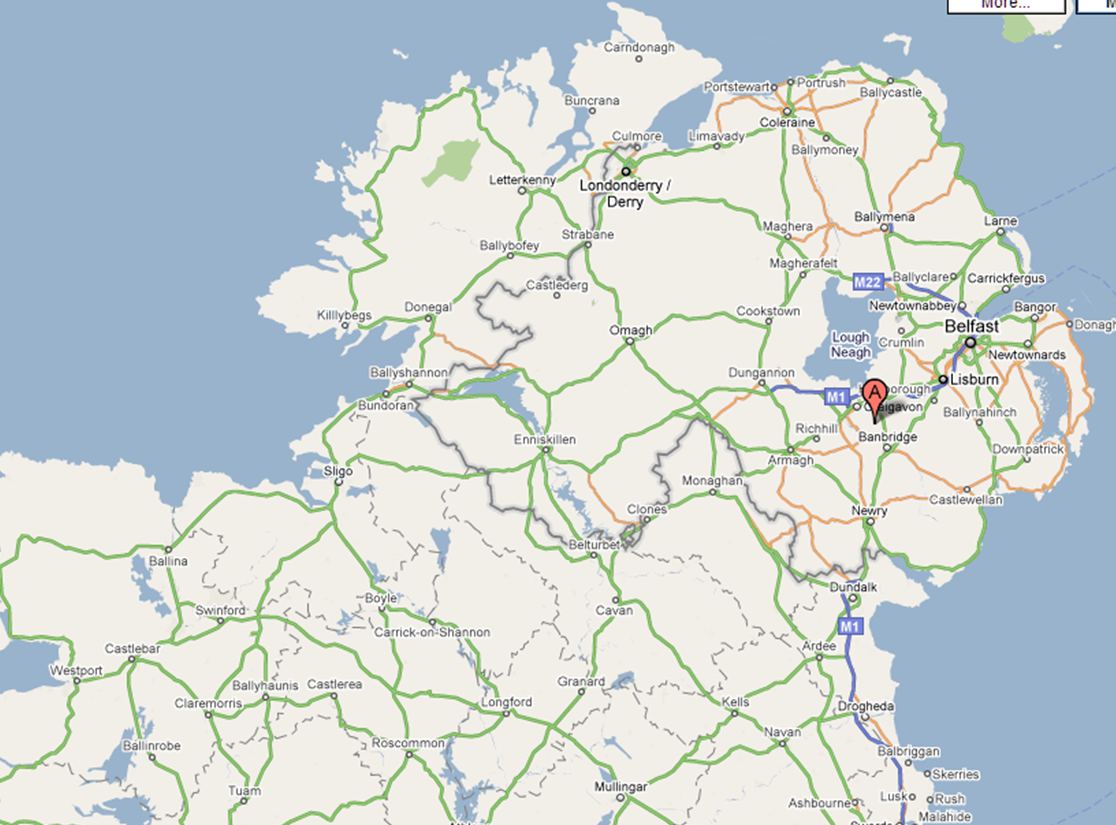
James Little/Lyttle lived all of his adult life (and was probably born) in County Down, Ulster, South East of Lake Neagh. His farm was in the Townland of Clare, about half way along the Clare Road that runs from just South of Waringstown (where his Presbyterian church records were kept) toward Gilford (where his mail was picked up). This is adjacent to land that belonged to the Levingstons, which is no doubt relevant to his first marriage in some way.

Eight years after James' marriage to Rachel, in the spring of 1864, Griffith's Valuation identified the home and outbuildings as Lot #27 at the Southwest corner of Clare Road and a road that is called Crowhill Road to the North and Low Town Road to the South.

At the time, his property consisted of 25 acres, 2 roods, and 10 perches, using the old measures.

St. Colman's (Lot 28), located kitty-korner from the main Lyttle home, was (and is) located at the site of a "mass rock" (a gathering place for prayer). It had been used by Catholics for centuries before Hugh Magennis acquired the 1334-acre Townland of Clare in 1583. Many of the surrounding lands remained in the hands of the (Sir Art) Magennis family until that group fell into disfavor in 1641 by supporting the wrong side in an uprising. The Stewarts (of Ards) gained control of the whole area. By the time of the Valuation, that land (along with another 5,000 acres of County Down) was owned by Alexander J.R. Stewart. And yes, this is the same church that bought surrounding lands from Rachel's mother-in-law.

It is interesting to think that two of the patches he did not own were the ones marked as Lot 22 (the Orange Hall) and Lot 28 (St. Colman's Catholic Church). At some point, they must have co-existed peacefully in close quarters. As of 2009, when Google took pictures of the area, the Hall (top) looked boarded up, while the Church (bottom) was still going strong.
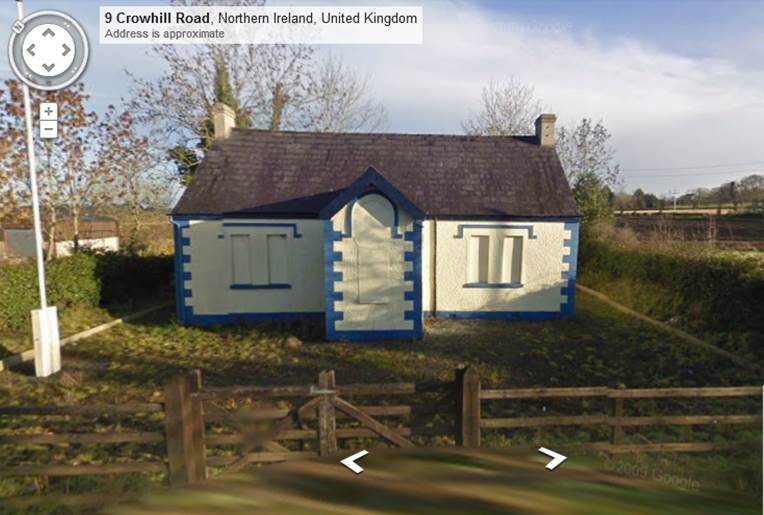

That whole area was part of Tullylish parish, which was known for fine linen weaving. The weavers who worked at mills in nearby towns stayed in rented cottages (cotter houses) at Clare and other small towns. James Little/Lyttle leased the farmlands from the Stewarts and, in turn, rented out cotter's houses on the property to sub-tenants.
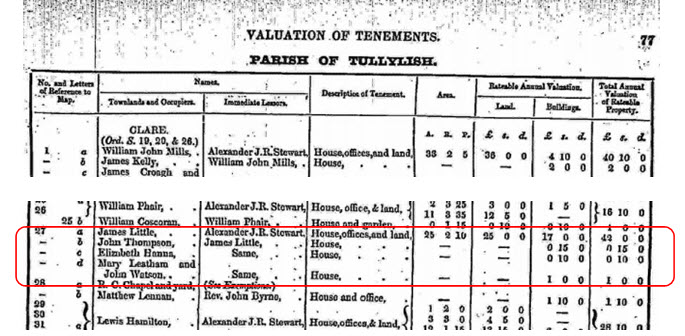
A few months later, the adjacent lot (#26 on the map) was transferred to my great-grandfather by neighbor William Fair. This document mentions a lease that goes back to 1824, perhaps with James Little/Lyttle's father at this same location.

The McCullaghs
James Little/Lyttle's friend Robert McClave McCullagh was married to Mary Jane Hawthorn (the daughter of Francis Hawthorn of Meenan, near Poyntz Pass).

The McCullaghs (sometimes spelled McCullough) lived at Annaghdroghal at the SouthEast corner of Lough Neagh in Kilmore townland, part of Shankill, Down (Grid Reference J0863). Although my family always said that the name meant "hill of bad fortune," it seems to mean simply "big marsh" [Angelique Day & Patrick McWilliams. 1992. Ordinance Survey Memoirs of Ireland: Parishes of County Down III/1833-1838 Mid-Down Vol. 12. Belfast: Queen's University, p. 139].
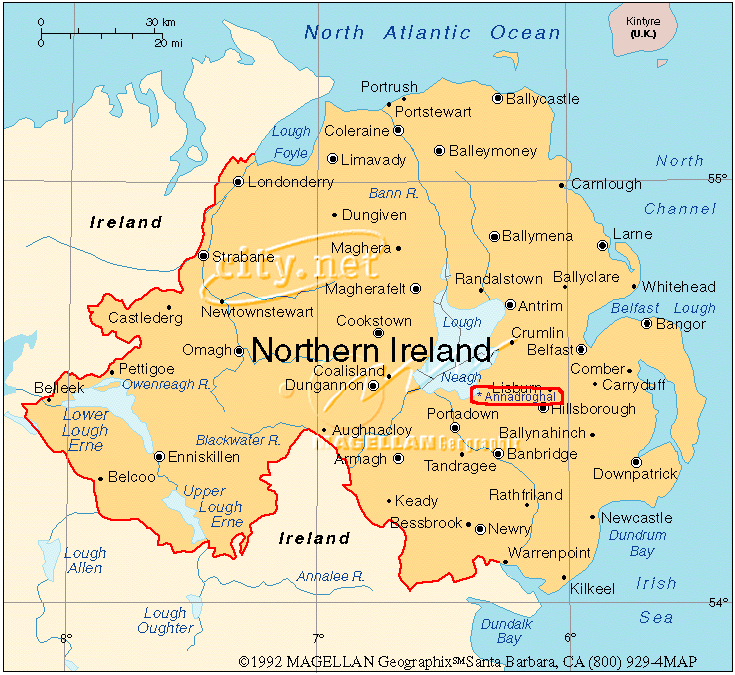
That farm (Lots 1 and 2) was next door to the home of John Elliott since 1760 (Lots 3,4,5, and 6). That makes sense, since the Elliotts were another of the Border families (a much bigger one) from the Dumfriesshire area of Southern Scotland, directly adjacent to the home of the Little clan at Meikledale (which is just North of Langholm). Today, the location of that Elliott/McCullagh farm is the site of the bridge over the Lagan Navigation Canal [Thrift, Gertrude, Ed. 1918. Index of Irish Wills: Dromore, Newry, and Mourne Vol. 4. London: Phillmore & Co., p. 39].

From 1794 until the 1930s, there were tow paths along the canal where horses pulled barges all the way to Lisburn to enter the larger canal to the port city of Belfast. Today, that bridge is the starting place of a walking tour and/or bicycle route along the path of the old canal.

The 78-acre McCullagh farm there was owned by Henry Waring, descendant of Colonel William Waring, after whom nearby Waringstown is named. The McCullaghs also rented out cotter houses to sub-tenants.

On July 12, 1864, the McCullaghs gave birth to Eliza Jane "Jennie" McCullagh.

Then, in 1871, Robert and Mary Jane moved to the 18th Century stone Fortland House with 90 acres of land, about four miles North of Moira and a mile and a half East of Aghalee. This is where Jennie grew up with her famous brother Sir Crawford McCullagh, (thrice Lord Mayor of Belfast, et cetera).
Sir Crawford
By the time of the 1901 census, Robert and Mary Jane could be found living with another daughter's family at Cornakinnegar, Armagh ... very near their original farm at Annodroghal.

"Jennie"
On June 30, 1885, about 10 months after the death of Rachel and at the age of about 58, James Little/Lyttle married Jennnie who was nearly 21 years of age.

The first child born to James and Jennie was a son named James Alexander in 1887. Alexander was the name of James' (and almost everyone in the area's) landlord, Alexander J.R. Stewart. That child did not survive. When a second son (my grandfather) came along on July 31, 1889, he was named James Andrew. However, the Lyttles were not about to pay another $2 fee to register the new birth and get a certificate, so he never had one. This did not cause him much trouble, as he was usually referred to as the Rev. Dr. James A. Lyttle and no one was concerned about what the initial A. stood for. However, there were interesting discussions with church officials and the Canadian Pension Plan as he neared retirement age.

The next child was Florence Jemima (known as Florrie Pat), born November 22, 1890. She went on to work her way up in the Buying department at Eaton's retail store and travelled extensively in Britain and Europe seeking women's fashions. At the time of my grandfather's death in 1964 (when she would be about 74) she was still listed as Florence Lyttle from Toronto, so presumably she was unmarried. The third child was a son, Johnny, who would live four years from 1892-1896.
Howard Francis was born in 1894. He went on to father Crawford Lyttle who produced, among other children, Yale Lyttle (in the white "Canadian" T-shirt and cap). Yale lives near my dad at Owen Sound in Canada today, has contributed insights to this report, and has recently completed a trek through the family's former territories. He even stayed at Abbeydene (the new name for Lismara, Sir Crawford's old home) while in Belfast, and reports being treated like royalty because of his relationship. His brother, Ron Lyttle, has also contributed to this report.

On April 23, 1896, Albert Samuel was the fourth surviving child. He was described as a talented pianist with a nervous disposition who never married (euphemisms?). The fifth and last child of this marriage was Rachel Violet ("Auntie Vi"), born April 11, 1898 when James Little/Lyttle was apparently 71. Vi went on to marry Robert Brown Donald and they both lived happily and fruitfully into their nineties, producing three children and eight grandchildren. Violet's baptismal document spells the name Lyttle instead of Little. We asked my grandfather why the spelling finally settled this way, after having varied back and forth between Little and Lyttle over the years. He would only quip, with a twinkle in his eye, "I think it had something to do with a horse." We suspect that spellings had to be settled when home postal delivery came to the area, around the time of Auntie Vi's birth.

For decades, our family thought of my great-grandfather as "James Lyttle the 7th," misreading the notation for father (Fth) above.
By the time of the 1901 census on April 18th, The Lyttles had more houses rented out.


My uncle, Orville Ross Lyttle (the source of the vast majority of this data), reports that they had 72 acres at this time: considerably more than the 25 or so at the time of the Griffith's Valuation 37 years earlier. This is easy to understand, if his empire now consisted of the original lands (Lot 27), plus the adjacent property of William Fair (Lot 26), and the nearby Levingston lands (Lots 63, 64, and 67-72).

Two homes were rented out to the Joseph Maxwell and William Maxwell families.

Across Clare Road, there were three homes, two of which were occupied by the families of Elizabeth Thomas and Ann Lennon with the third one vacant. The next building (105) was the Roman Catholic Chapel, which is of course St. Colman's Church, today.

Two of the other houses on the main property were unoccupied, as was the schoolhouse to the west of his farmhouse. In this listing, it almost seems as if the school belonged to the Lyttle family, but that seems very unlikely. That school was a small one, supported by its students in 1836 as part of the National (secular) system and, by 1901, identified as a Presbyterian school.
Widowed
About six months after that census, on October 2, 1901, James Lyttle died and was buried at the old Tullylish graveyard two miles South of Clare at Laurencetown.
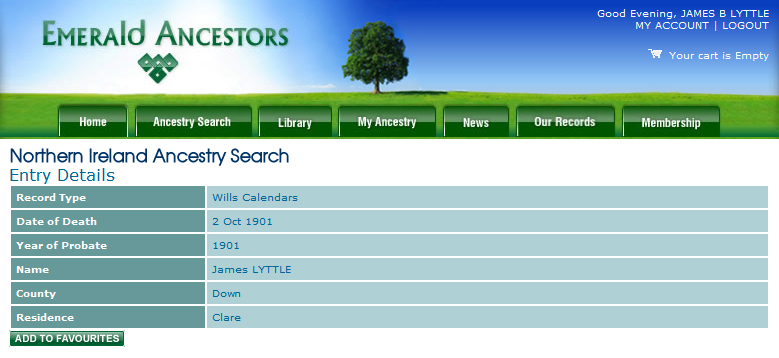

The grant, awarded on November 27, left Jennie 1,445 pounds, 10 shillings, and 9 pence, which her brother (Sir Crawford) helped her invest.

The farm was taken over by the (John Lewis) Gilpin family: Methodists from County Armagh. They held the homes on both sides of Clare Road, between the Presbyterian Meeting House (#67) that used to be the National School and the R. C. Chapel (#74) that would become St. Colman's Church.

The family of their son, Lewis Alfred, was still living in the house when my grandfather re-visited in 1957. They had tea and visited together at that time, and my grandfather was able to find the 30 granite markers he had helped his dad install at the entrances to their various fields.
My grandfather took some pictures during that visit, which can be compared with current Google Maps images, about fifty years later.
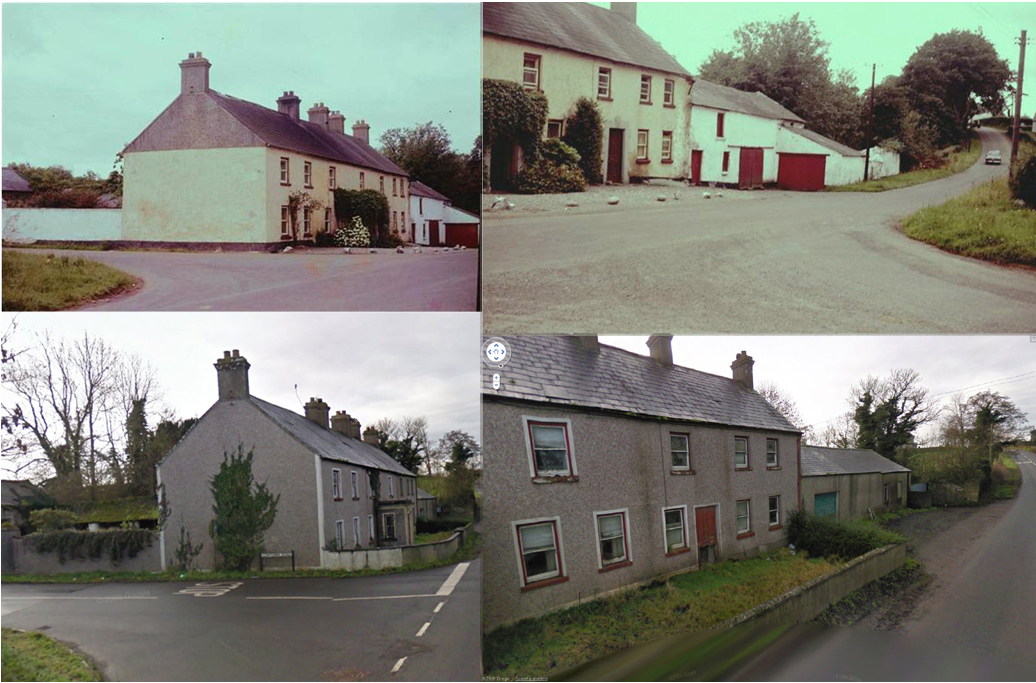
It looks like the farmlands have been sold off; and the house seems to be in disrepair. In fact, all the windows on the ground floor have since been closed off with cinder block and the building might be used as a storage area today.

The address is now 87 Clare Road, Waringstown, LURGAN BT66 7SA (Property Reference: 5374) and consists of only 197 square meters valued, for assessment purposes, at 100,000 pounds.

Here is a map of part of Ulster (Northern Ireland), with some highlights noted.

Belfast
After the death of my great-grandfather, Jennie had lived on the return from her investments for a while and my grandfather apprenticed to Lisburn grocer John Gibson (who had been a witness at James' and Jennie's wedding). My grandfather often spoke of making home deliveries on a bicycle, mixing each customer's favorite blend from a recipe list, using the assortment of teas in his bicycle carrier. Later, Jennie was to marry Thomas Brown, a 36-year-old grocery importer.

She moved the whole family to his store at 334 Woodstock Road in Belfast, BT6 9DP.
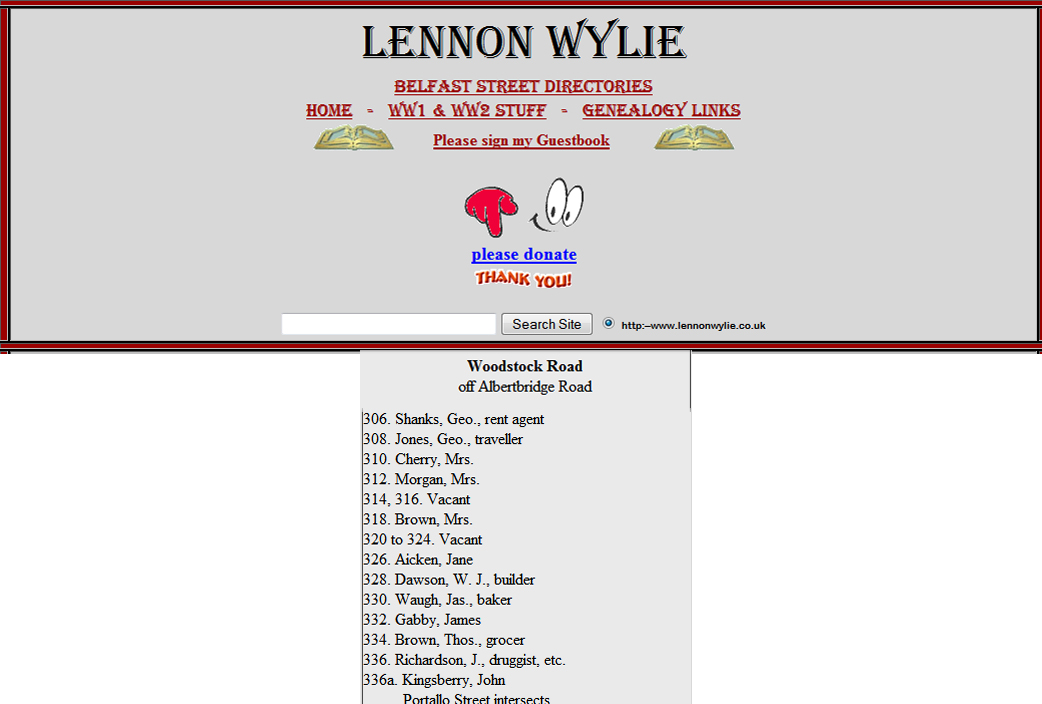
Later, that store would be combined with the neighboring 332 Woodstock Road to become R. Fleeton & Co., family grocers. Today, 330/332 Woodstock Road is the home of Fosters Family Butchers.

That second marriage did not last long, however, as Thomas died of bronchitis a few months later--more than two months before his son Tommy was born.

Mr. Brown was buried in Section P, Class 3, Number P40 of the Belfast cemetery, leaving Jennie another estate of just over 913 pounds.

The widow and her family moved into 587 Lisburn Road in Belfast, BT9 7GS by the time of the 1911 census, conducted at the beginning of April. That home was very near the Windsor Presbyterian Church, where Jennie and Thomas Brown had been married, and the rowhouse now hosts a Barnam's ice cream shop with solicitors' offices above.

Jennie and her young son Tommy were being called Brown at the time and Jennie was listed as 45, although she would in fact be turning 47 in three months. My grandfather was listed as 23 (because of the birth certificate situation) and as a grocer's assistant. The other children had been employed by Sir Crawford and were thus listed as draper's assistants, except for Vi and Tommy who were still in school.

Canada
On Friday, May 12, 1911, Sir Crawford paid $50 to send my grandfather and his eldest sister "Florrie Pat" (Florence) to Canada via Liverpool, second class.


They traveled on the Lake Manitoba (Canadian Pacific) to Montreal.
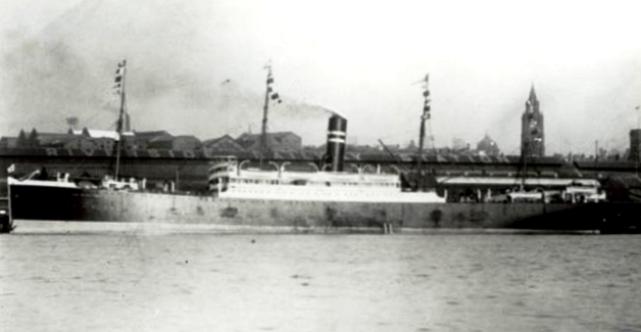

Then they made their way to Toronto, where they were able to locate "the milkman's brother" on Wellesley Street. They spent that Sunday night there and, the next day, were given jobs by Mr. Allen: a friend of Sir Crawford and Director of the Timothy Eaton store.
The next Year on Sunday, May 12, 1912 (about 40 days after the departure of the Titanic from the same port, and about three weeks after its sinking), Sir Crawford sent the rest of the family: his sister Jennie and her children Howard (17), Albert (15), Violet (11), and young Thomas (7). They travelled on the Montrose (also Canadian Pacific), "saloon."

I do not know what it means to travel saloon class. Maybe they slept in the bar, or at least on that level of the ship. It seems that all of the fees had been marked down, perhaps in response to the news about the fate of the Titanic.
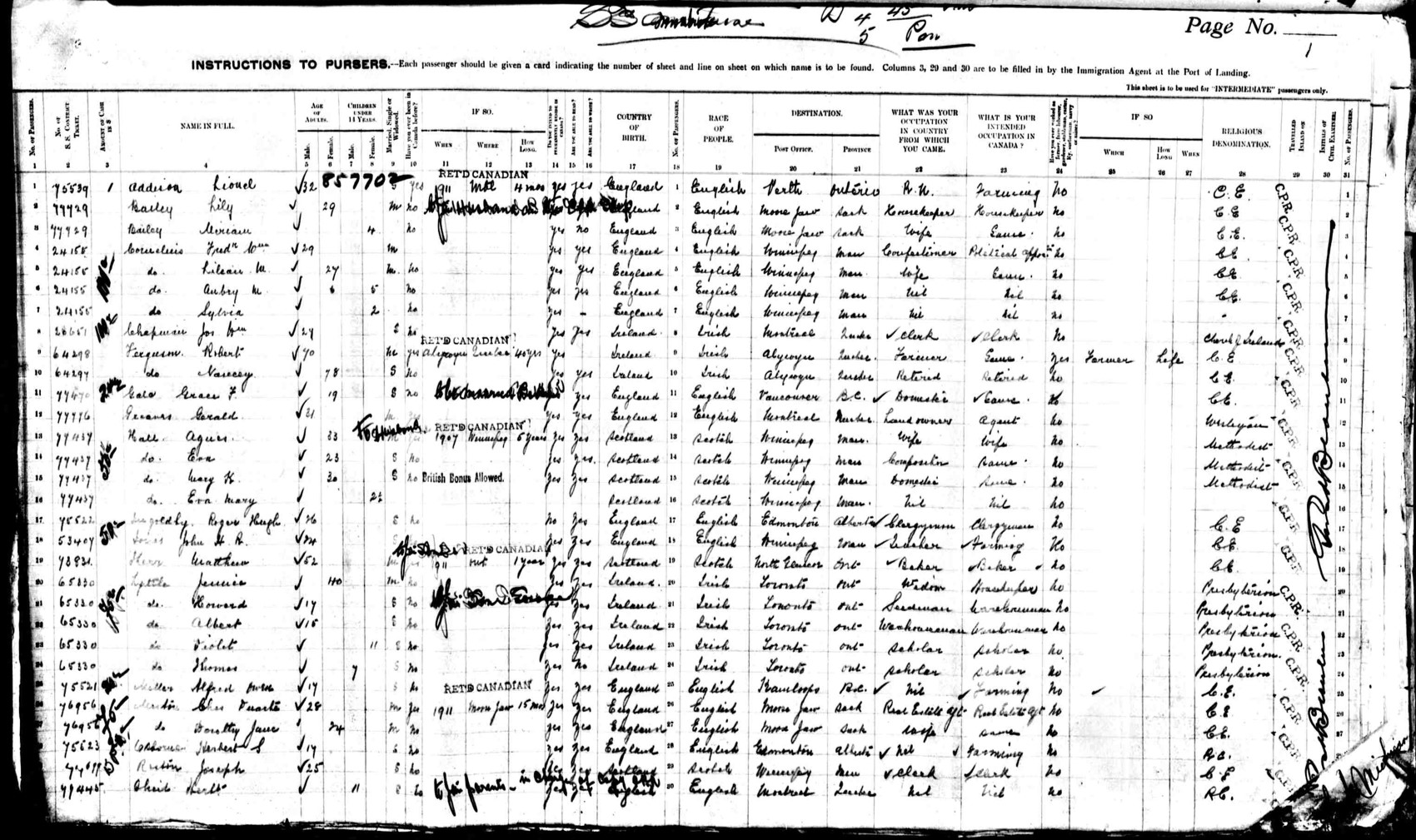

In the year since the census, both Jennie and Thomas seem to have permanently adopted the name Lyttle. Jennie was quite charitably listed as being 40 years of age, although her birth certificate suggests she would have been turning 48 in about a month.

By June of 1912, the whole family was in North America, where they would stay for the rest of their lives. The people in the picture are, from left to right at the back, Howard, Albert, Tommy, and James. From left to right in the front are Florence Jemima (Florrie Pat), Elisa Jane (Jenny), and Rachel Violet (Auntie Vi).
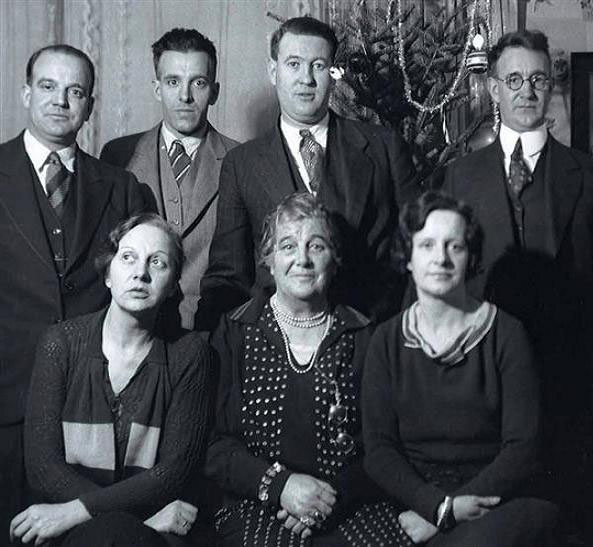
The New World
My grandfather (James Andrew Lyttle) studied the courses leading to a theology degree from Queens University by correspondence. In 1917, he was ordained as a Presbyterian minister at Hanbury (North of New Liskeard), where he was ministering to men in the logging and mining camps. Sometime around 1920, Sir Crawford would come to visit the family in Canada and give them the down payment for a house. In the summer of 1925, Congregationalists, Methodists, and most Presbyterians in Canada amalgamated to form the United Church of Canada and my grandfather thus became one its first ministers.
The Rev. Lyttle met Marguerite Christina Cameron Brown, who was working in a chemical laboratory at Carnegie Mellon in Pennsylvania, and married her in 1926. Nine months later, they produced my dad, James Cameron Lyttle. At that time, they lived in Capreol, another of the harsh mining towns of Northern Ontario. The Rev. Lyttle raised money to build a church. When the local theater closed down, he supported the church (and his own fascination with moving pictures) by buying a projector and running an amateur movie theater in the basement.
By 1932, he was ministering in the Scarborough area, where he produced his other son, Ross Orville Lyttle. Rev. Lyttle served as the secretary and later president of the Toronto Conference of the United Church of Canada. By 1938, though, he was back in the north lands. He finally settled down in 1943, when he moved to 140 Lake Street in North Bay, Ontario. There, he took over as the Superintendent of Home Missions for Northern Ontario and Quebec and held that position until his retirement. He was made a Doctor of Divinity by Queen's University in 1951 and established his own local church (Pinewood United Church) in 1960, the time of his retirement. After "retiring," he served as director of church extension, president of Queens Theological Almumnae, and chairman of the authorizing board of the Northern Ontario University Association.
In February of 1964, just after learning that the college he had worked to establish (Huntington, now part of Laurentian University) was funded and would go forward, the Rev. Dr. James A. Lyttle died at his home in North Bay. His elder son, James Cameron Lyttle (pictured below), went on to become an electrician, electrical inspector, and then Code Application Technician for the electrical code in the Province of Ontario. He also served in Freemasonry as Grand Master for Ontario, registered a patent for a machine control system, and produced four children (the eldest of whom is your humble author). The Rev. Lyttle's younger son, Ross Orville Lyttle, was a high school guidance counselor, Registrar of Trinity Western University near Vancouver, the father of two great children, and the source of the vast majority of the research for this story.



